| NGC 4543 | |
|---|---|
 NGC 4543 (SDSS DR14) | |
| Observation data | |
| Constellation | Virgo |
NGC 4543 is an elliptical galaxy in the constellation Virgo. [1]
| NGC 4543 | |
|---|---|
 NGC 4543 (SDSS DR14) | |
| Observation data | |
| Constellation | Virgo |
NGC 4543 is an elliptical galaxy in the constellation Virgo. [1]

The New General Catalogue of Nebulae and Clusters of Stars is an astronomical catalogue of deep-sky objects compiled by John Louis Emil Dreyer in 1888. The NGC contains 7,840 objects, including galaxies, star clusters and emission nebulae. Dreyer published two supplements to the NGC in 1895 and 1908, known as the Index Catalogues, describing a further 5,386 astronomical objects. Thousands of these objects are best known by their NGC or IC numbers, which remain in widespread use.

NGC 1, also occasionally referred to as GC 1, UGC 57, PGC 564 or Holm 2a is an intermediate spiral galaxy of the morphological type Sbc, located approximately 210 to 215 million light-years from the Solar System in the constellation Pegasus. It was discovered on 30 September 1861 by Heinrich d'Arrest.
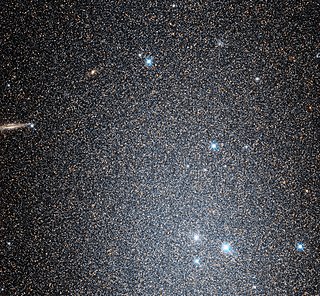
NGC 147 is a dwarf spheroidal galaxy about 2.58 Mly away in the constellation Cassiopeia. NGC 147 is a member of the Local group of galaxies and a satellite galaxy of the Andromeda Galaxy (M31). It forms a physical pair with the nearby galaxy NGC 185, another remote satellite of M31. It was discovered by John Herschel in September 1829. Visually it is both fainter and slightly larger than NGC 185. This means that NGC 147 is more difficult to see than NGC 185, which is visible in small telescopes. In the Webb Society Deep-Sky Observer's Handbook, the visual appearance of NGC 147 is described as follows:
Large, quite faint, irregularly round; it brightens in the middle to a stellar nucleus.

NGC 246 is a planetary nebula in the constellation Cetus. The nebula and the stars associated with it are listed in several catalogs, as summarized by the SIMBAD database. It is roughly 1,600 light-years away. The nebula's central star is the 12th magnitude white dwarf HIP 3678. It is not to be confused with the Rosette Nebula, which is also referred to as the "Skull."

The Eyes Galaxies are a pair of galaxies about 52 million light-years away in the constellation Virgo. The pair are members of the string of galaxies known as Markarian's Chain.
The Späth family created one of the world's most notable plant nurseries of the 19th and early 20th centuries. The nursery had been founded in 1720 by Christoph Späth but removed to the erstwhile district of Baumschulenweg in south-east Berlin in 1863 when Franz Ludwig Späth succeeded his father Ludwig as manager when aged only 25. By the end of the 19th century, the nursery was the largest in the world, occupying 120 hectares. In 1874 Franz built a mansion on the site, now part of Humboldt University and, five years later, established an arboretum.
4543 Phoinix is a large Jupiter trojan from the Greek camp, approximately 63 kilometers in diameter. It was discovered on 2 February 1989, by American astronomer Carolyn Shoemaker at the Palomar Observatory in California. The assumed C-type asteroid is possibly elongated and has a longer-than-average rotation period of 38.9 hours. It is one of the 60 largest Jupiter trojans and was named after Phoenix (Phoinix) from Greek mythology.
Przyłubie is a village in the administrative district of Gmina Skulsk, within Konin County, Greater Poland Voivodeship, in west-central Poland.
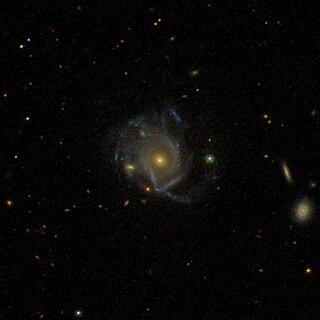
NGC 60 is an Sc type spiral galaxy in the Pisces constellation. NGC 60 is noticed for its unusually distorted spiral arms, which are commonly due to gravitational effects of neighboring galaxies, but there are no galaxies around NGC 60 to allow this.
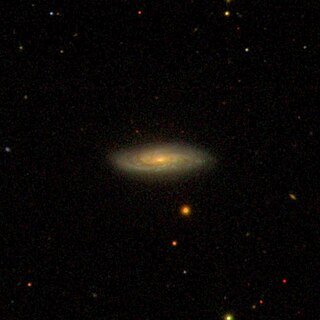
NGC 54 is an edge-on spiral galaxy in the constellation of Cetus. The galaxy was discovered by Wilhelm Tempel in 1886, and he defined it as "very faint, pretty small, round." The galaxy is 90,000 light years in diameter, making it slightly smaller than the Milky Way.
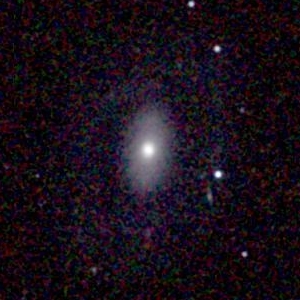
NGC 210 is a barred spiral galaxy located roughly 67 million light-years from the Solar System in the constellation Cetus. It was discovered on October 3, 1785 by William Herschel and later added to the New General Catalogue.
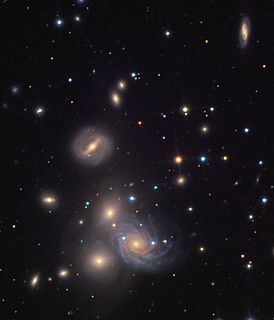
NGC 67 is an elliptical galaxy located in the constellation Andromeda that was discovered on October 7, 1855 by R. J. Mitchell, who described it as "extremely faint, very small, round". The galaxy belongs to the NGC 68 group, which also contains the galaxies NGC 68, NGC 69, NGC 70, NGC 71, NGC 72, and possibly NGC 74.

NGC 68 is a lenticular galaxy, and the central member of the NGC 68 group, in the constellation Andromeda. The galaxy was discovered on September 11, 1784, by William Herschel, who observed the NGC 68 group as a single object and described it as "extremely faint, large, 3 or 4 stars plus nebulosity". As such, his reported location is between NGC 68, NGC 70, and NGC 71. By the time Dreyer looked at the galaxies to add to the NGC catalog, however, he was able to tell that the single galaxy observed by Herschel was in fact 3 adjacent galaxies, and cataloged them as NGC 68, NGC 70, and NGC 71.

NGC 70 is a spiral galaxy located in the constellation Andromeda. It was discovered on October 7, 1855 by R. J. Mitchell and was also observed on December 19, 1897 by Guillaume Bigourdan from France who described it as "extremely faint, very small, round, between 2 faint stars"

NGC 156 is a double star located in the Cetus constellation. It was discovered on 1882 by Ernst Wilhelm Leberecht Tempel.

NGC 375 is an elliptical galaxy located in the constellation Pisces. It was discovered on September 12, 1784 by William Herschel. It was described by Dreyer as "pretty faint, small, round, brighter middle." Along with galaxies NGC 379, NGC 380, NGC 382, NGC 383, NGC 384, NGC 385, NGC 386, NGC 387 and NGC 388, NGC 375 forms a galaxy cluster called Arp 331.
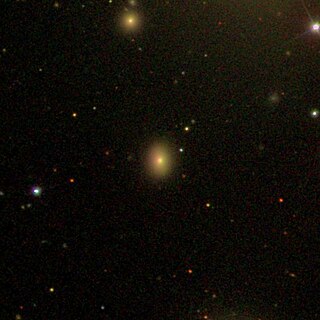
NGC 386 is an elliptical galaxy located in the constellation Pisces. It was discovered on November 4, 1850 by Bindon Stoney. It was described by Dreyer as "considerably faint, small, round." Along with galaxies NGC 375, NGC 379, NGC 382, NGC 383, NGC 384, NGC 385, NGC 387 and NGC 388, NGC 386 forms a galaxy cluster called Arp 331.

NGC 480 is a spiral galaxy located about 546 million light-years away from Earth in the constellation Cetus. NGC 480 was discovered by American astronomer Francis Leavenworth In 1886.
Janice E. Nevin is an executive who in 2014 became President and CEO of ChristianaCare Health System. She is the first woman to be the head of Delaware's largest hospital system.